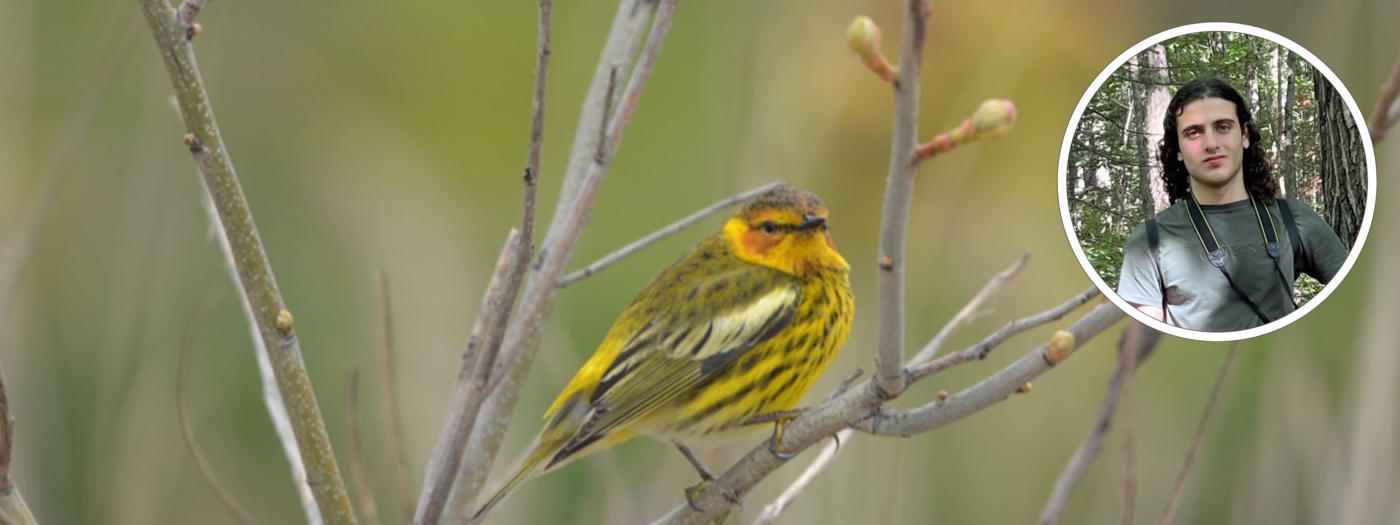Let’s dive into some of the top birding spots in the Great Lakes region, where you can experience the peak of warbler migration and discover some of the most renowned locations for birdwatching. We’ll also discuss the remaining warblers in the Setophaga genus that weren’t covered in the previous article.
Some natural areas in the Great Lakes region are a major attraction for birders during the spring migration season, which lasts from late April to the end of May. The most famous of these is Point Pelee National Park on Lake Erie, a sand spit at the the junction of two migratory flyways – attracting thousands of warblers from dozens of species, in addition to other songbirds. Pelee National Park also hosts the festival of birds every year – a brief two-week long period in May where the entire park caters to the needs and interests of birders. Eastward, Rondeau Park, another Lake Erie sandspit, offers a similar experience, but is less crowded during peak migration season. My personal favorite spring birding location is Pelee Island with its many beaches, verdant forests, and rocky alvars.
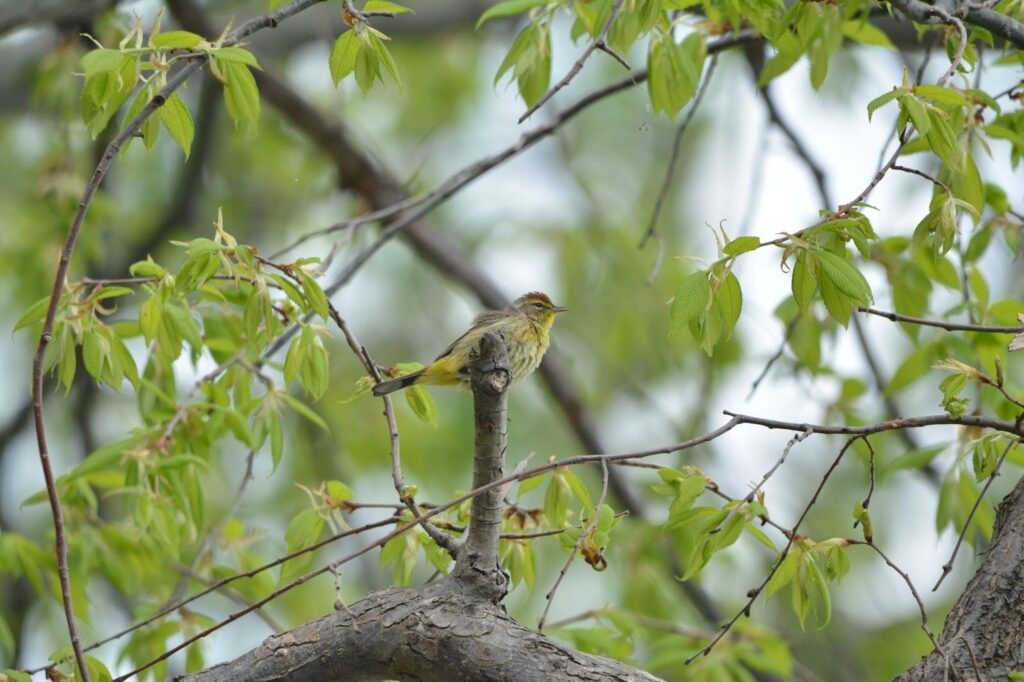

Each spring, Palm Warblers are one of the earliest warblers to arrive in Ontario, often two weeks ahead of most other species. They are most often observed in the Great Lakes region during the spring and autumn migration periods. Adult male Palm Warblers are yellow and white birds, with grey wings, bright yellow cheek patches and a distinctive brown cap. Unlike most other warbler species, female Palm Warblers have similar plumage to males. Palm Warblers prefer to breed in boreal coniferous forests – their primary habitat in the summer months. They are among the northernmost of all warblers, with some birds occurring as far as the Great Slave Lake in the Northwest Territories (the only other warbler species that breed this far north are Blackpoll Warblers and Yellow Warblers). Nests are placed on the ground, usually near the base of a large shrub or tree. Palm Warblers are ground-feeding insectivores, though they also consume seeds and fruits during the winter months, which allows them to winter further north than many other species. Their wintering distribution stretches from Central America and the Caribbean north to New Jersey, although wintering birds are scarcely observed west of the Appalachians.

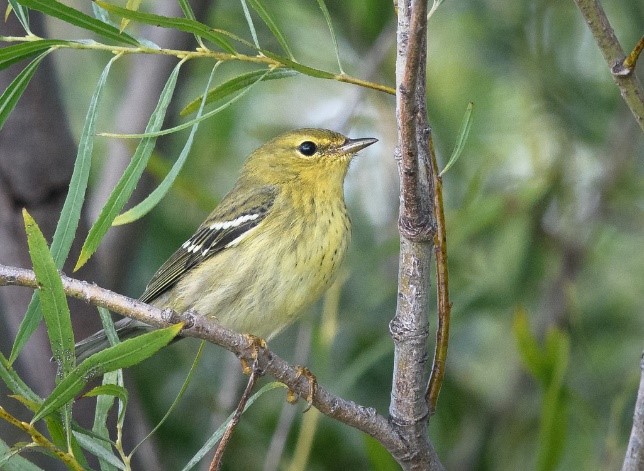
Blackpoll Warblers are a boreal forest species observed in the Great Lakes region during the spring and fall migration seasons. Breeding males are distinctive in appearance, possessing black caps, a yellow bill, grey wings and a white underside. Breeding females have similar, but more washed-out plumage than the breeding males. Nests are usually placed near the trunks of spruce (Picea sp.) and fir (Abies sp.) trees within boreal coniferous forest habitat. After July, both sexes will molt into their olive-yellow non-breeding plumage, but will retain their 2 characteristic white wing bars important for identifying the species. They are found in their breeding areas, which stretch from Alaska to Labrador, between mid-May and mid-September. Blackpoll Warblers winter in northern South America, including the western portion of the Amazon Rainforest.
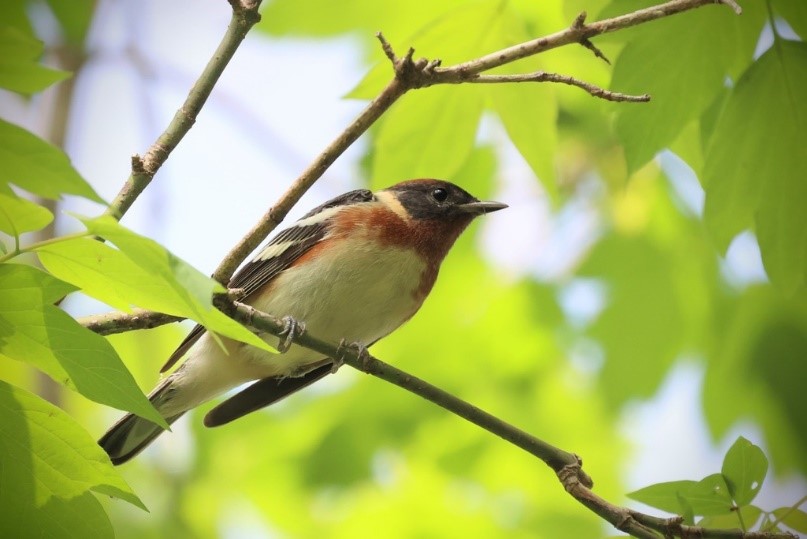
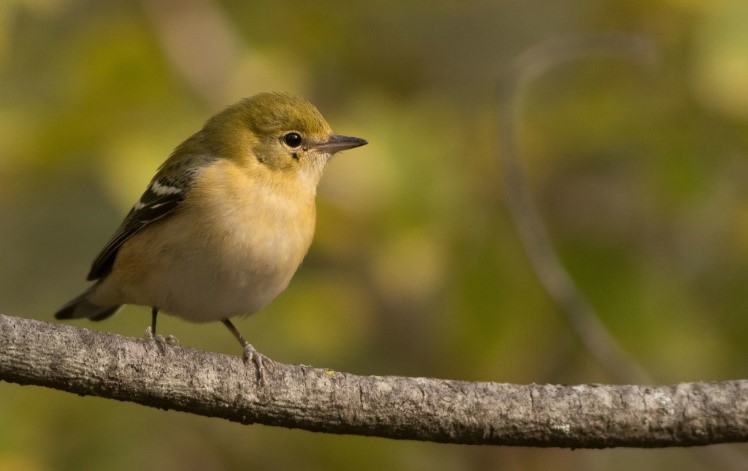
Bay-breasted Warblers are another northern warbler species most often observed in the spring and autumn migration season in the Great Lakes region. Breeding males show a mosaic of black, grey, and white plumage (including two white wingbars) with a bright brown throat and cap. Females lack the bright brown plumage, but the other plumage features are similar to males. This warbler breeds in Canada’s boreal coniferous forest and mixed forest regions of the northern Great Lakes. Nests are typically placed near dense foliage within the lower sections of spruce and fir trees. Bay-breasted Warblers occur in Ontario between early May and early October. This species winters in the Bahamas, Cuba, Jamaica, and the northern coastal zone of Colombia and Venezuela.
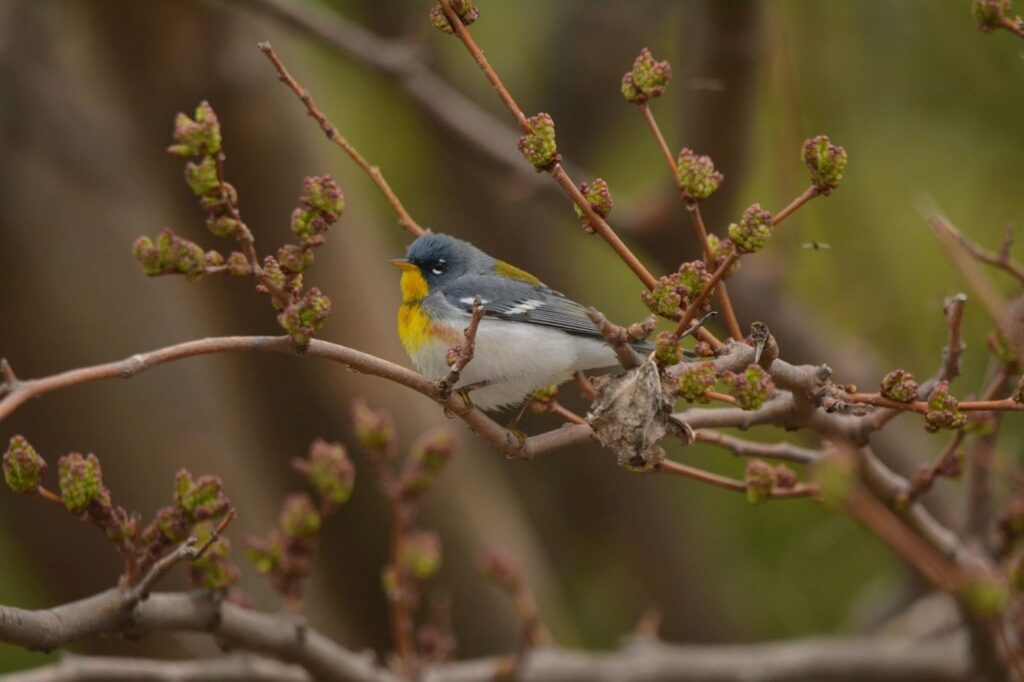
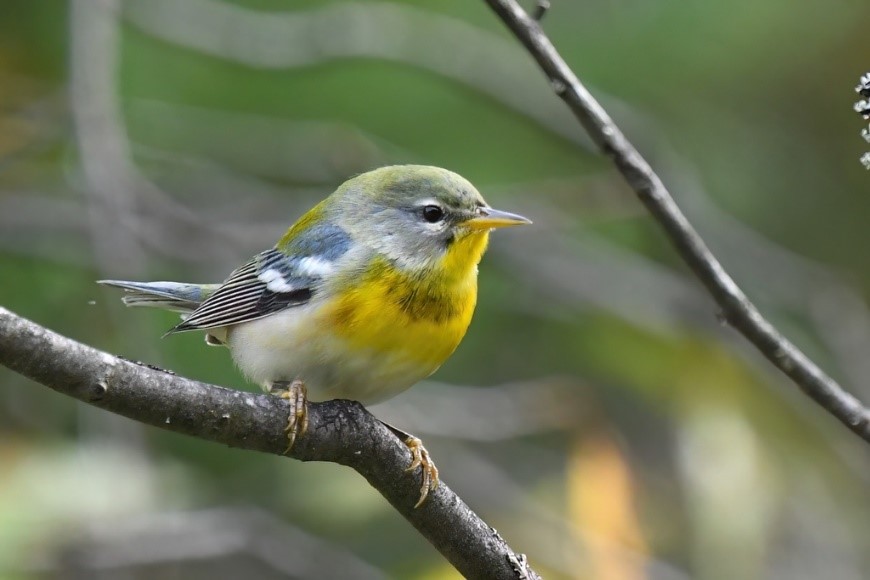
Northern Parulas are one of the more widespread species of warblers in eastern North America. Adult males have a bluish head and back, with a bright yellow throat, a bright orange breast band, and a white rump. Females have similar but more washed-out plumage. Both sexes have grey wings with 2 white wing bars. In the Great Lakes Region, Northern Parulas live and breed in a wide variety of forested habitats, including deciduous forests, coniferous forests, mixed forests, oak savannas, and pine savannas. The breeding range of Northern Parulas stretches from Florida to the northern shore of Lake Superior, westward towards the Great Plains. They avoid breeding in major agricultural regions where natural vegetation cover is less than 30% – these include the farming areas centered around Chatham-Kent and Perth County in Ontario. Parulas are observed in Ontario between late April and early October. In the autumn, these birds winter in the rainforests and mangroves of Veracruz eastwards to the Yucatan Peninsula and the Caribbean Islands.
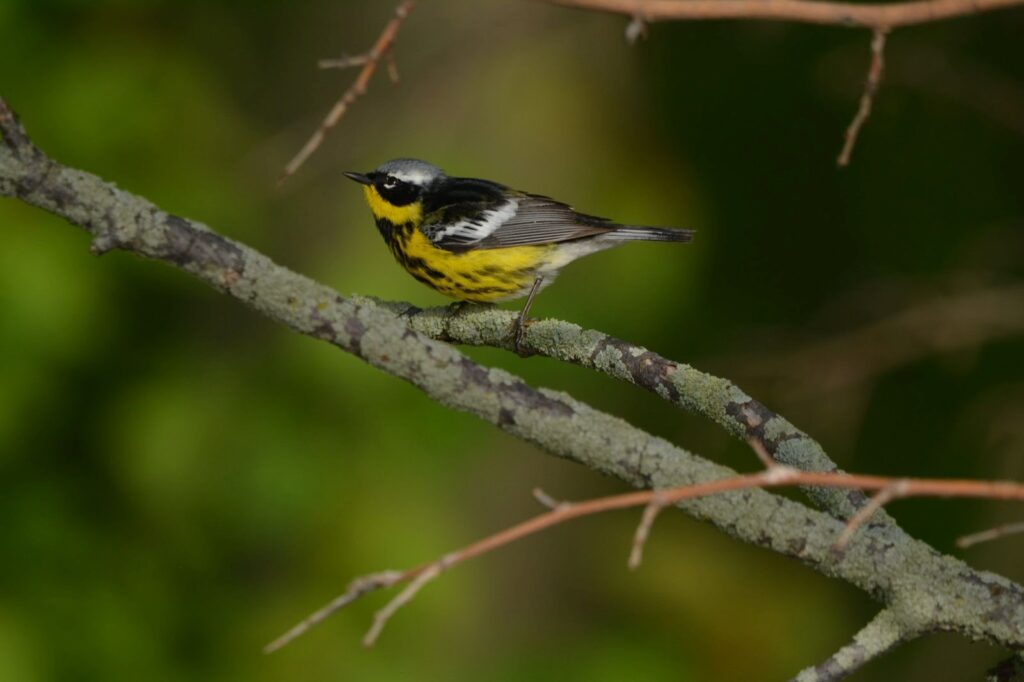

Magnolia Warblers are a common species of warbler breeding in the Great Lakes region and northward throughout the boreal forest region. Male Magnolia Warblers have spectacular plumage, which includes a bright yellow belly with black streaking, black cheeks, white eyebrow lines, and a grey cap. Female Magnolia Warblers are similar, except they have an entirely grey face. The wings of both sexes are grey with a single white wingbar. Magnolia warblers prefer to breed in coniferous and mixed forests; preferring to nest in spruce and Balsam Fir (Abies balsamea) throughout their range, but also hemlock trees (Tsuga canadensis) in the Great Lakes region. They are observed in Ontario mostly between early May and early October. Magnolia Warblers winter throughout Central America and the Caribbean Islands; preferring rainforests, montane forests, fruit plantations, and mangrove swamps.

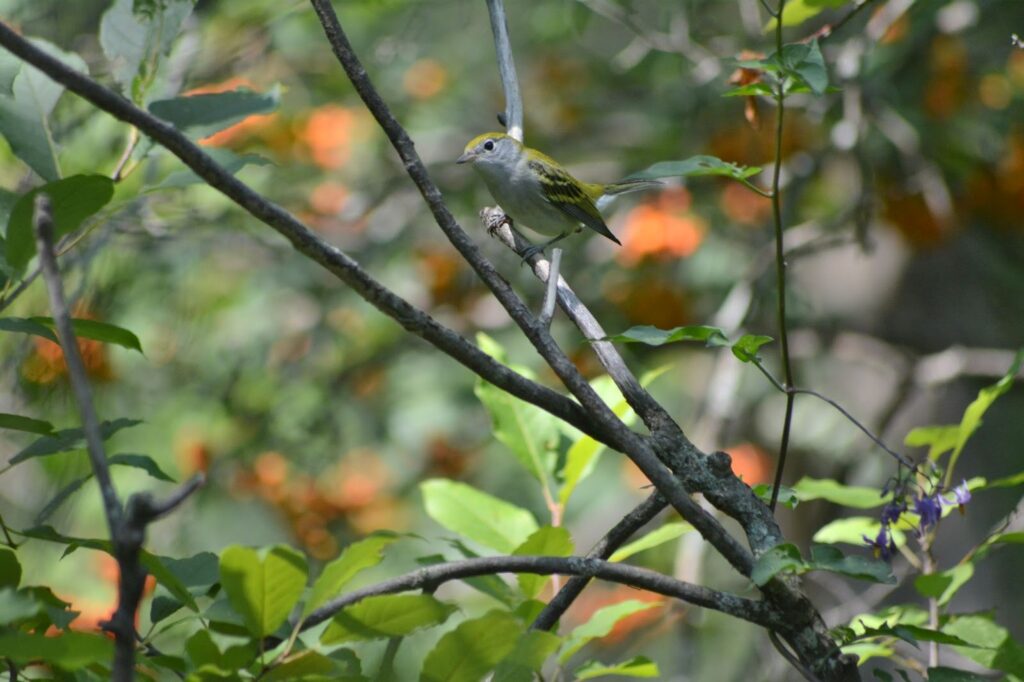
Chestnut-sided Warblers are a fairly common warbler species in the Great Lakes region. Males are striking in appearance – they have a yellow cap, rusty-brown (“chestnut”) flanks, a black mask, white cheeks and a white belly. Females have an olive-yellow back and cap, a distinctive white eyering, and grey undersides, though they may develop faint chestnut flanks during the breeding season (April-July). Both sexes have grey wings and 2 white wing bars. Males only retain their beautiful spring plumage in the breeding season – they become much drabber in the autumn; resembling females but retaining their chestnut flanks.
Chestnut-sided Warblers are most often found in shrublands, woodland-savannas, and early-successional forests – their preferred breeding habitats. Nests are most often placed in undergrowth less than 3m from the ground. Chestnut-sided Warblers are distributed throughout Ontario west to Saskatchewan and eastward to the Appalachian Mountains and Atlantic coast. They are most often observed between early May – early October. Chestnut-sided Warblers winter in the Yucatan Peninsula, Central America, the Caribbean Islands, and the northern coastal areas of Colombia and Venezuela.
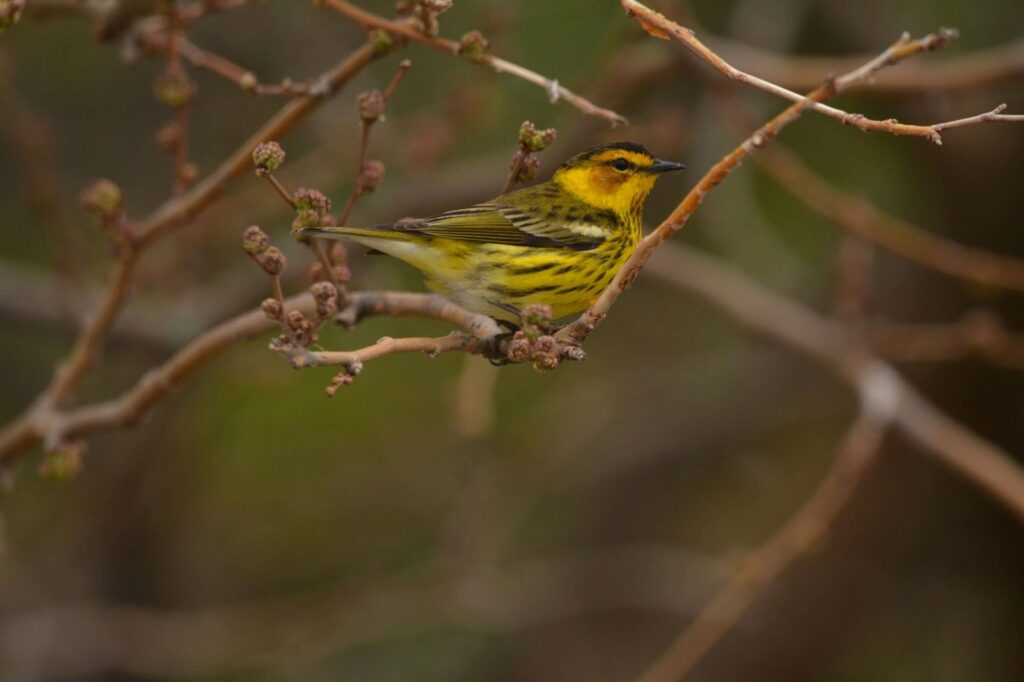

Adult male Cape Male warblers are among the most gorgeous of all North American songbirds. Each bird has a yellow head with a grey cap and bright orange cheek, olive-grey wings and back, one white wingbar, and a yellow underside complete with black streaking. Females have similar plumage, but do not possess the bright orange cheek and black cap characteristic of male Cape May Warblers. In the summer, Cape May Warblers are most often observed in spruce-fir forests within the Canadian Shield region. The primary food source of Cape May Warblers are spruce budworms. Nests are usually placed high up on coniferous trees, similarly to Blackburnian Warblers. Cape May Warblers are observed in Ontario from late April to early October. The breeding areas stretch in a semi-contiguous area from northern Alberta eastward to Nova Scotia. Wintering grounds are the Carribean Islands and the mangrove swamps of Yucatan south to Nicaragua – a similar wintering distribution to the Black-throated Blue Warbler.
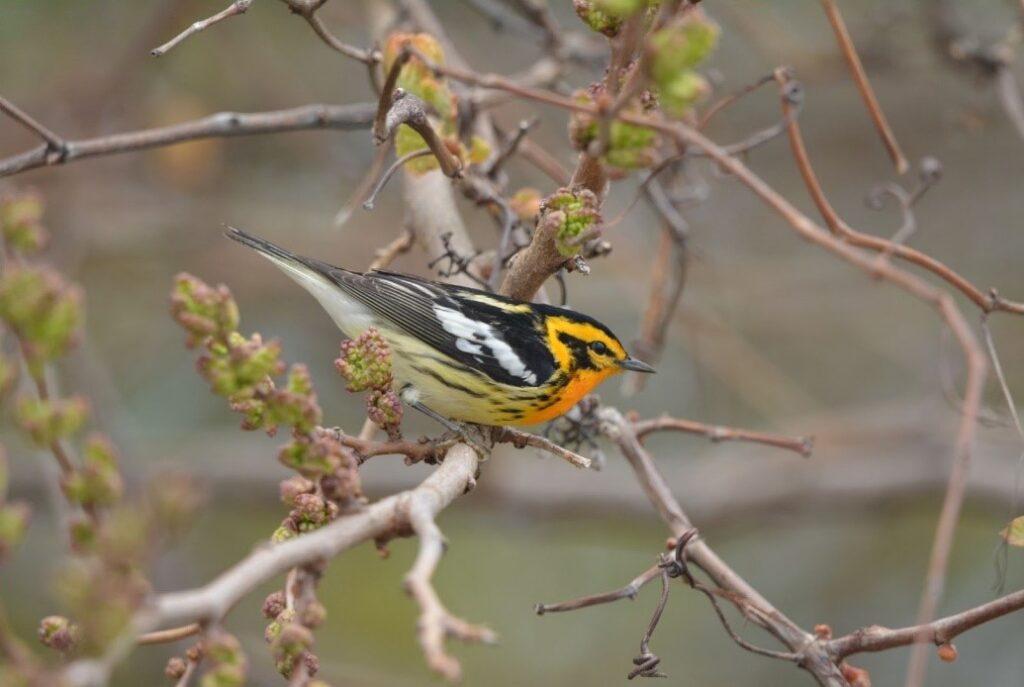

Blackburnian Warblers have among the most vibrant and impressive plumage of all Setophaga warbler species; a delightful sight to any birder. Males have orange heads and alternating black and white streaking throughout the year. Females have a rusty-tan head and belly, with grey wings and 2 white wing bars. They are a common and widely distributed species in the Great Lakes region. Blackburnians also occur westward through Manitoba and eastwards throughout the Appalachian Mountains to the Atlantic coast. A woodland bird, Blackburnian Warblers prefer nesting in coniferous forests and mixed forests, though they also tolerate woodland-savannas and pure deciduous forests where other forested habitats are not available. Nests are placed high in the canopy. Blackburnian Warblers are observed in Ontario between early May and late September. They are a longer-distance migrant – their wintering grounds are the Andean highlands and northwestern coastal areas of South America.
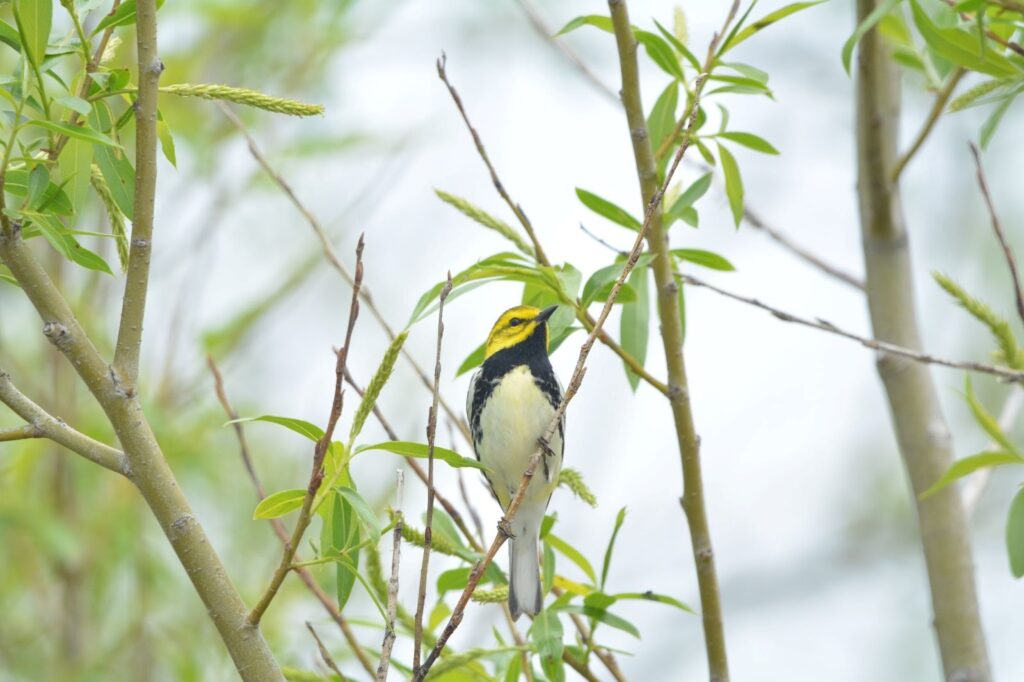
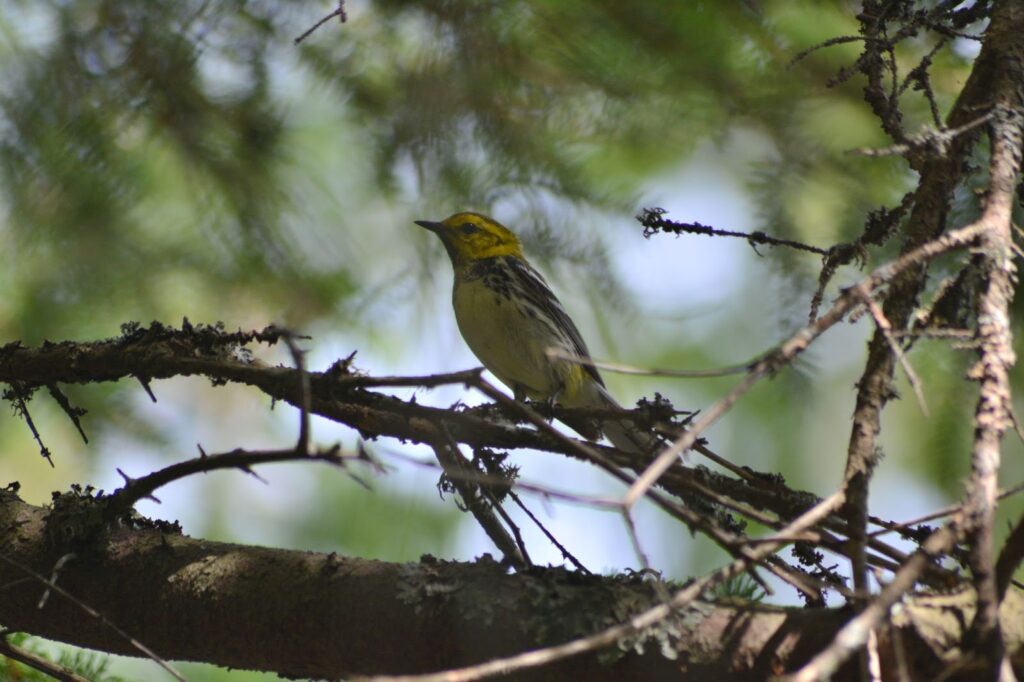
One of the most abundant warblers in the forests of Ontario are Black-throated Green Warblers. Both males and females have yellow heads with golden cheeks and a darker eyeline and cap, which contrasts with the belly, which is white, and the grey wings, each with 2 white wing bars. Males are distinguished from females by the presence of a black bib between the belly and the head. Black-throated Green Warblers are found in both coniferous and deciduous forests, which constitutes their breeding habitat. These warblers breed primarily north of the Lake Erie region from the mixed forests in the Great Lakes region north into the boreal forest, and west to Alberta. Black-throated Green Warblers occur in Ontario from late April to early October. This species winters in tropical areas of Central America, the Caribbean Islands, and South America north of the Amazon River Basin.

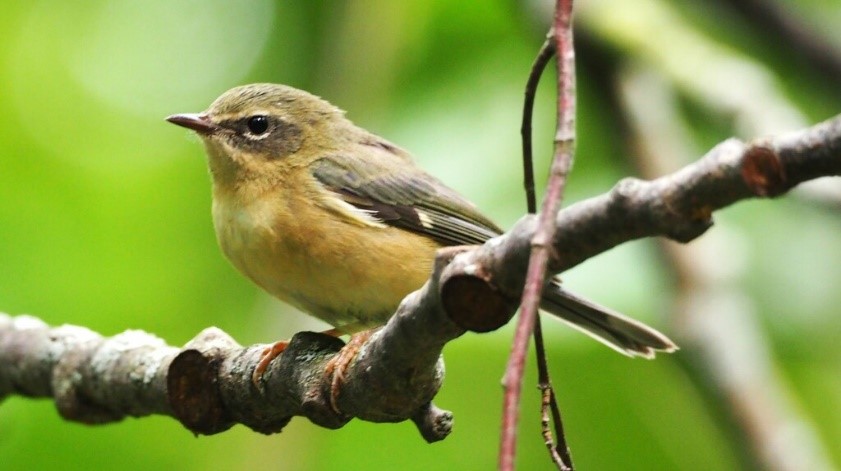
Black-throated Blue Warblers are one of the more common warblers in the forests of the Couchiching region. Males are distinctive in appearance – blue on the upper side, with a black mask and white on the belly. Females are yellowish with grey wings, a white eyebrow stripe, and a unique white patch on the wing. It is most readily observed in the interior areas of upland deciduous hardwood forests, especially those dominated by Sugar Maple (A. saccharum). Ideal habitat for Black-throated Blue Warblers in the Couchiching region include much of the Awenda Peninsula, and the upland forests of the Oro Moraine (which the latter unfortunately remains threatened by development, making the area much in need of increased conservation attention).
The Black-throated Blue Warbler makes its nest in dense understory vegetation within it’s deciduous forest habitat. Black-throated Blue warblers breed throughout the mixed and deciduous forest regions of the Great Lakes region, north to the margins of the boreal forest region (but not within). It can be observed in Ontario from May to September, where afterwards, Blue-throated Blue Warblers migrate southward towards the tropics. Wintering grounds include the Caribbean Islands and the coastal mangroves of Mexico’s Yucatan Peninsula – further east than many related warbler species.


The Cerulean Warbler is a southern species with a disjunct population occurring on the Awenda Peninsula in the Couchiching region and likely also on associated islands (Christian Island, Beckwith Island, Hope Island, Giant’s Tomb and Beausoleil Island). Elsewhere in Canada, Ceruleans are only found in the Lake Erie region, the Cataraqui-Frontenac area, and a few areas near the Kawartha Lakes north of Peterborough. Males appear light blue (lighter than the Black-throated Blue) with 2 wing bars and a whitish belly. Females are very unique, with a bright green cap, olive back, and yellowish underside. All of these areas contain large tracts of upland deciduous hardwood forests, the Cerulean Warbler’s preferred habitat. Unlike Black-throated Blue Warblers, which prefer the forest understory, Cerulean Warblers are more often observed in the canopy of upland deciduous forests – this species nesting location. Cerulean Warblers are typically observed in Ontario between May and September, afterwards migrating south their wintering grounds within the tropical Andes.
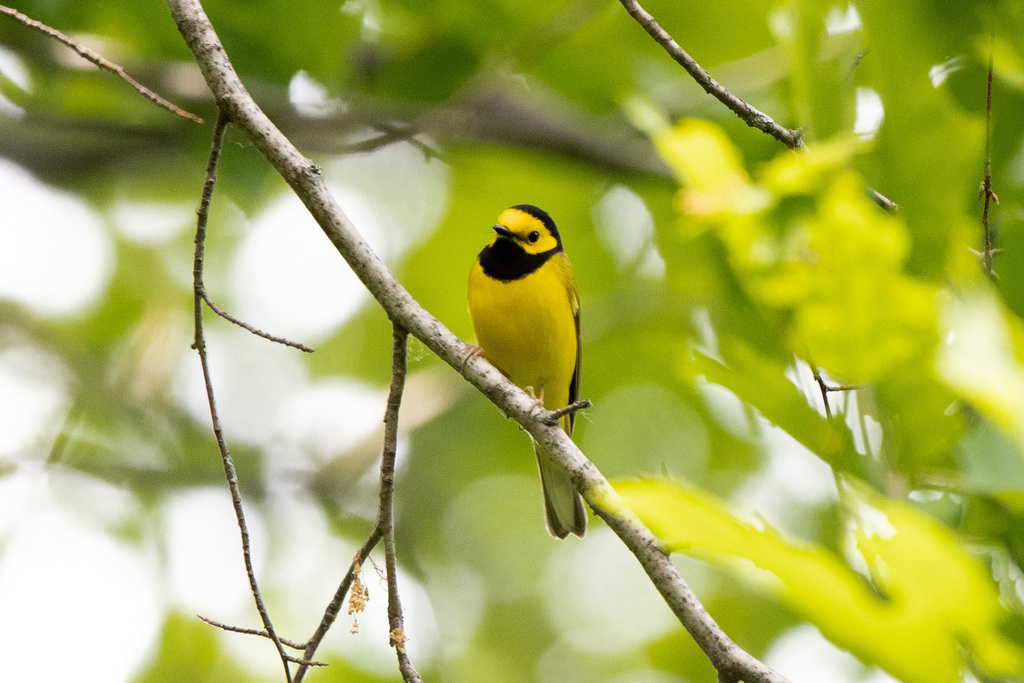
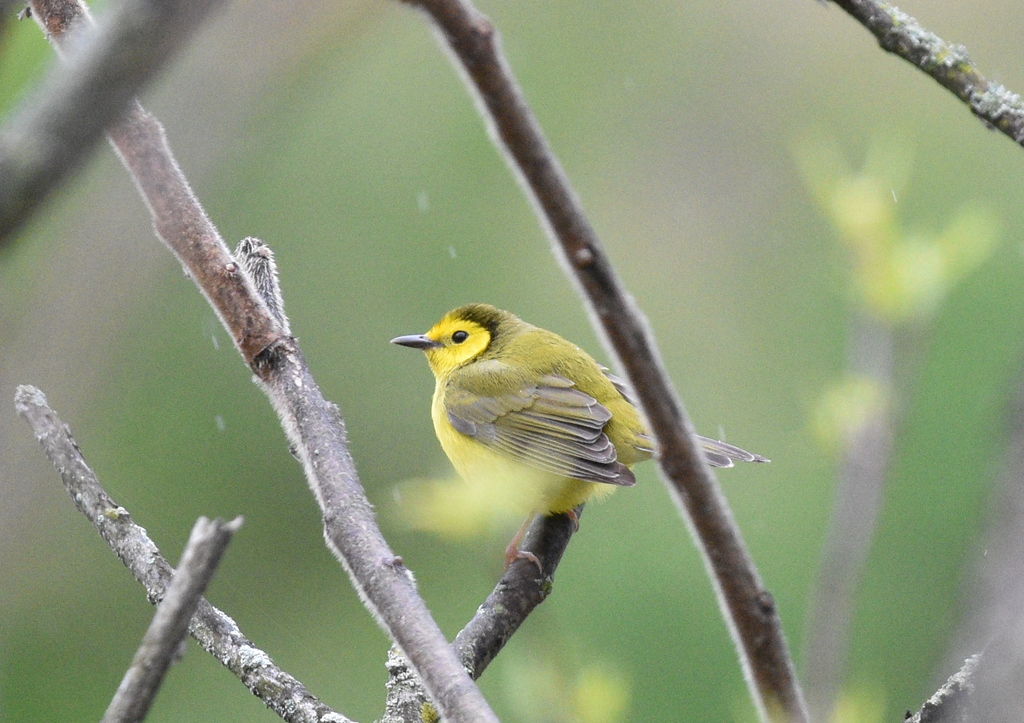
In Canada, Hooded Warblers are primarily restricted to the deciduous hardwood forests of the Lake Erie lowland region. However, smaller populations of Hooded Warblers breed in more northerly regions, such as around Awenda Provincial Park in the Couchiching region. Male Hooded Warblers are bright yellow with an olive-green wing and a distinctive “hood” – a black cap connected to a black throat. Female Hooded Warblers lack the characteristic hood of male Hooded Warblers, but retain a dark grey cap. The preferred breeding habitat is mature deciduous hardwood forests with a small number of canopy gaps. Nests are placed in forest understory vegetation of 1 – 5 m from the ground, within the recent canopy gaps. This species has been expanding its breeding range northward over the previous few decades. In the Great Lakes region, Hooded Warblers are present from mid-May to mid-September. They winter in Central America and the Caribbean.

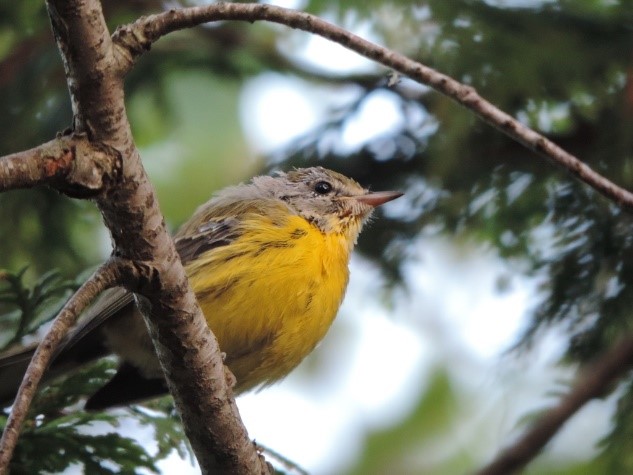
Despite the name, Prairie Warblers do not typically occur in grasslands, but rather within Oak-Pine savannas, shrublands, and early successional forests – it’s breeding habitat. In Ontario, Prairie warblers are distributed in the woodlands and savannas of Pinery Provincial Park area on Lake Huron, the Long Point Region, and the Lake Huron coastal zone of the Massasauga region north of Lake Couchiching, eastward towards the Kawartha Highlands. The nests are typically placed in dense understory vegetation 1-5 m from the ground.
Male Prairie Warblers have impressive plumage – a full body of bright yellow with black streaking, with slightly darker wings and a distinctive brown patch on the back. Females have similar but more washed out plumage. Prairie Warblers are observed in the Great Lakes region from early May to late September. This species winters on the Caribbean Islands, and in the coastal mangrove swamps of the Yucatan Peninsula and Central America.
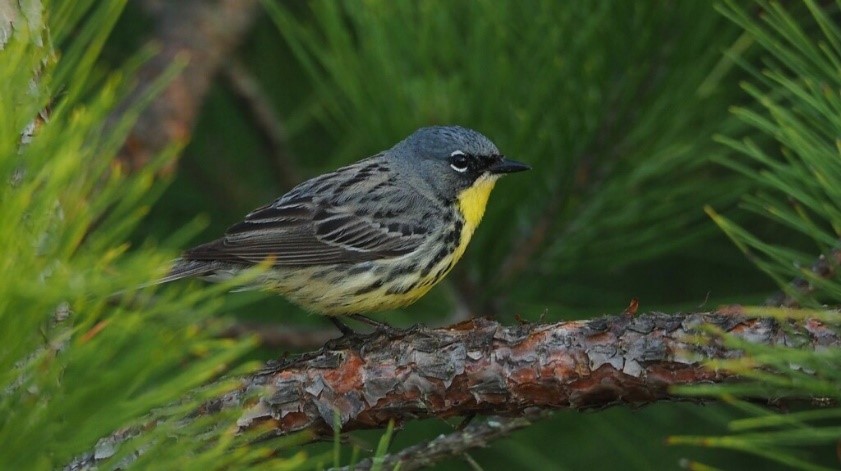
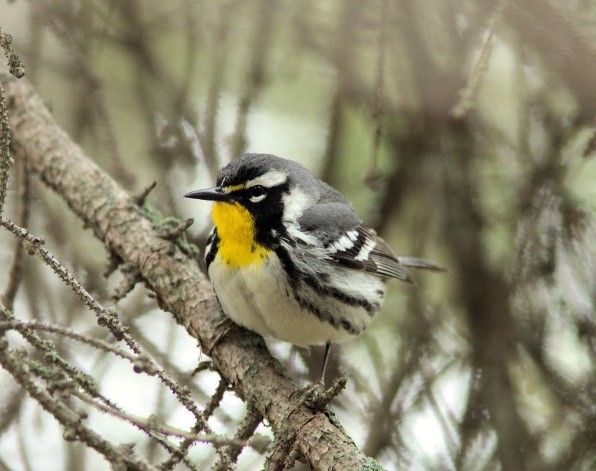
Kirtland’s Warbler is the rarest warbler in the Great Lakes region, breeding primarily in the northeastern areas of Michigan’s Lower Peninsula, where it is locally common within it’s primary habitat – young Jack Pine (Pinus banksiana) woodlands. However, Kirtland’s warblers have been breeding in the Petawawa region of Ontario since ~2008, and restoration efforts of young Jack Pine forest in the Couchiching region hope to reintroduce this warbler to areas where it was formerly present. Breeding male Kirtland’s Warblers are bright blue on the back, with a yellow belly. Females have similar but slightly fainter plumage.
Yellow-throated warblers are mostly found in the Southeastern United States but occasionally occur in Canada during the spring migration (April-May) and breeding seasons (May-July). It is similar in appearance and behavior to the Black-and-White Warbler (Mniotilta varia), but Yellow-throated warblers a distinctive yellow throat characteristic of the species. This warbler breeds in the canopies of open forests and woodland savannas. It is mostly found in the Lake Erie lowlands region in Canada, but occasionally it is found further north.
Enjoy your birding adventures and the vibrant world of warblers!
Article by Matthew Palarchio
Photos by Matthew Palarchio, unless otherwise indicated with a copyright (©) symbol.
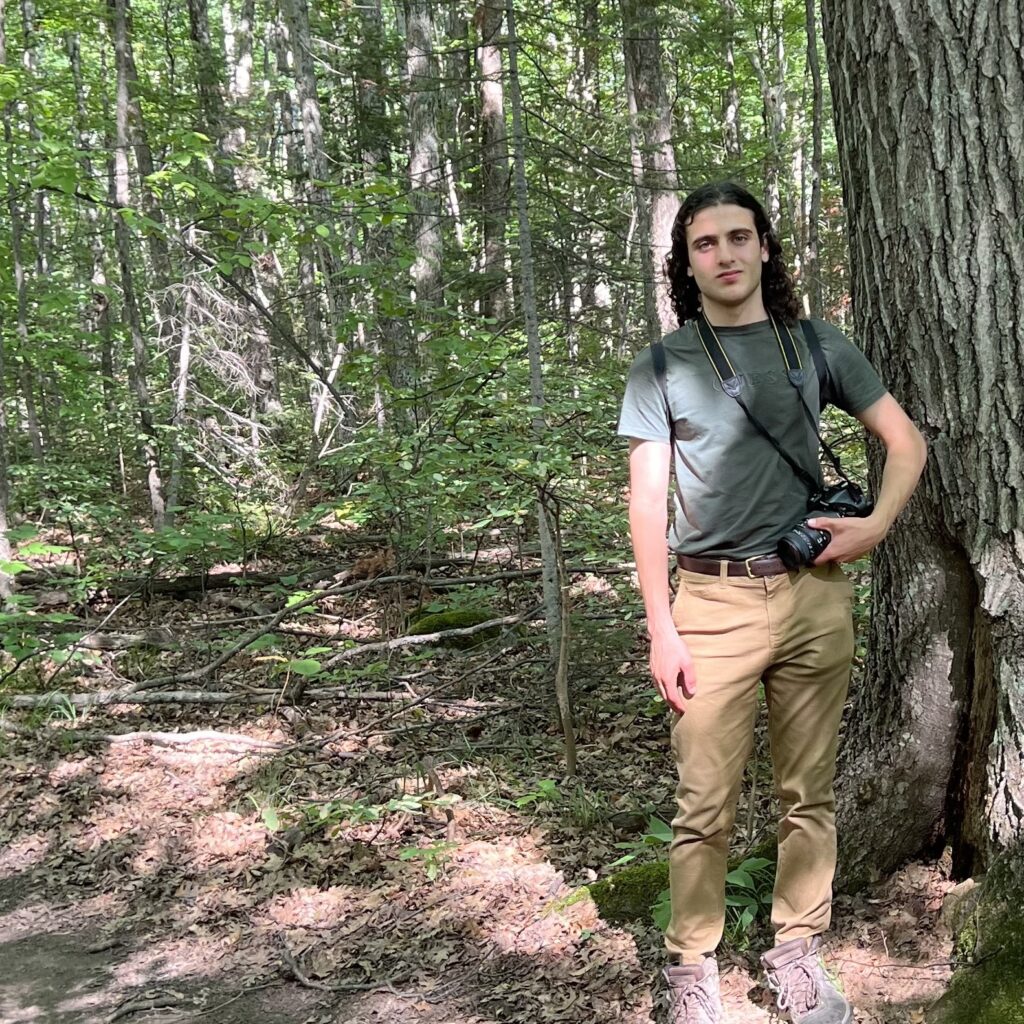
Matthew Palarchio is going into his fourth year of studies at the University of Western Ontario (pursuing an Honours BSc in Environmental Science). Matthew is a dedicated volunteer at several conservation organizations across Ontario, including Thames Talbot Land Trust, Long Point Basin Land Trust, and the Kensington Conservancy. He has previously been involved with Ontario Nature through their youth programme, participating in their Annual Gathering as well as their Youth Summit. Matthew is currently serving as a Director-at-Large with his local Naturalist club – Nature London. Enjoying outdoor activities in all seasons, Matthew is a hiker, skiier, birder and wildlife photographer.

